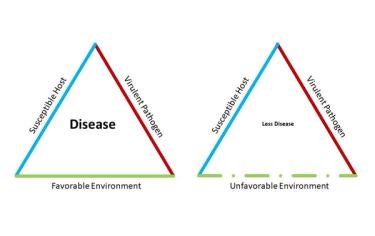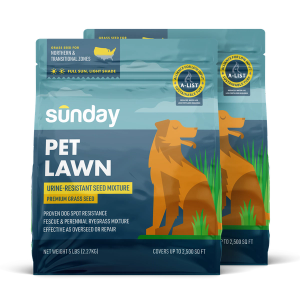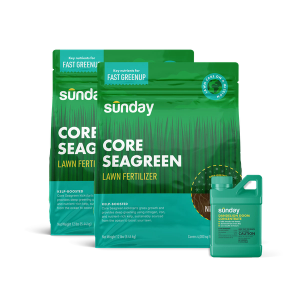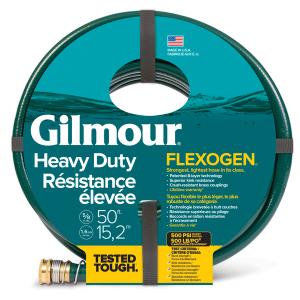What causes lawn disease?
Lawn diseases can be alarming. They can cause thinning, damage your lawn, and, in most severe cases, kill grass. Most of the time, lawn diseases don’t cause much direct damage and are mostly cosmetic.
Fungi are the main culprits for diseases in home lawns, but just because a fungus is present doesn’t necessarily mean lawn disease will become an issue.
Enter: The disease triangle

The three points on a disease triangle represent the three factors required for a disease to occur:
- A pathogen, like a fungus
- A susceptible host, or grass that particular fungus can infect
- The right environmental conditions
If any of these factors is missing, disease can’t occur. This is where prevention comes into play.
How to identify lawn diseases
Root diseases in lawns
- Fairy ring: circular rings of mushrooms
- Necrotic ring spot: straw-colored rings, often with healthy grass in the center (can look similar to pet patches!)
- Summer patch: circular patches of yellow or brown grass, often with orange or brown edges
Foliar diseases in lawns
- Anthracnose: yellow or bronze patches of wilted turf
- Brown patch: irregular 4-inch or larger patches of brown or yellow grass
- Dollar spot: 1-6 inch straw-colored patches; individual grass leaves will have white or tan lesions with reddish-brown edges
- Gray leaf spot: individual leaves have gray, olive, or brown lesions with a darker brown border
- Pink or gray snow mold: grayish to pink, matted patches
- Pythium blight: reddish-brown, slimy or cobwebby spots
- Red thread: pink to red patches; individual grass leaves will have reddish hairs or threads present
- Rust: yellow or rust-colored powder present on shoes, mowers, and grass leaves — this disease is typically more cosmetic and often does not cause significant damage to the grass.
Getting rid of lawn disease
Most lawns can withstand some disease pressure without the need for fungicides. When you do notice disease issues and want to avoid fungicide applications, these 3 steps can help get rid of disease:
- Audit your irrigation system to ensure you’re watering properly
- Reduce other lawn stressors:
- Sharpen your mower blades to ensure a clean cut
If you face the same disease issues season after season, consider switching to a more resistant grass cultivar or species.
Prevent lawn disease
We know it can be tempting to reach for the fungicides to help prevent—or treat—disease issues. But at Sunday, we try to limit harsh pesticide use and opt in for a more integrated pest management approach to lawn diseases, focusing on prevention in an effort to avoid disease issues (and fungicide use) in the first place.
Without preventative fungicide use, disease prevention should focus on the other two corners of the disease triangle: either changing the grass, or changing the environment.
- Grass selection. Some grasses are just naturally vulnerable to certain diseases, and resistant to others. Select high-quality, disease-resistant grasses suitable to your region to help prevent disease issues.
- Watering. Incorrect watering practices are one of the main issues leading to ideal environmental conditions for fungal growth. Wet leaves create the perfect conditions for the spread and growth of many fungal diseases. Water early in the morning to allow leaves time to dry off during the day, and water deeply and infrequently to build strong, healthy turf that is more resilient against disease.
- Fertilizing. A well-fed turf is a more disease-resistant turf. With too little nutrition, your grass might be too weak to fight off infection, but too much fertilizer can cause succulent growth that promotes some diseases.
- Mowing. Dull blades shred the grass, weakening the turf and opening the grass up to infection—while mowing too low can further stress the grass. Sharpen your mower blades regularly so you get a clean cut, mow at the right height for your grass type, and remove clippings if you have visible disease present, to avoid spreading fungal spores across the lawn.
- Stress. Stressed grass is susceptible grass. Address issues like compaction, shade, and traffic to reduce stress on your grass and help it withstand a little disease pressure.
Cited sources
Turf: Disease Management for Home Lawns. University of Massachusetts Amherst Extension.
Turfgrass Disease Control. University of Missouri Extension.
Turfgrass Diseases: Quick Reference Guide. University of Georgia Extension.
Photo credit: Donald Groth, Louisiana State University AgCenter, Bugwood.org



















